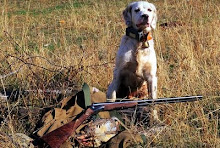 For field trialers, this is not a question - it is a must. But many people who have quality hunting dogs do not see value in breaking their pointing dogs steady to wing, shot and fall. Further, they question why it is required in almost all field trial formats.
For field trialers, this is not a question - it is a must. But many people who have quality hunting dogs do not see value in breaking their pointing dogs steady to wing, shot and fall. Further, they question why it is required in almost all field trial formats.I have seen many arguments over this subject. I have also seen almost no hunting dogs that were steady to wing and shot. Why?
The reason that most hunting dog owners provide is that they want their dog to 'get a head start on the retrieve' by going with the bird on the flush, even before the shot. Others seem to feel that it is simply unnecessary and just don't train for it. OK, but I would like to offer a few reasons, valid for many hunters. I doubt that these reasons would change many minds, and I believe that how people develop their bird dogs is up to them. But hear me out anyway...
Primary among reasons for steadiness in a bird dog is safety. You would be horrified if your hunting partner ran ahead of you when birds were flushed! "What's the matter with you, you wanna get shot!?" I think our dogs deserve the same level of concern.
For hunters of covey birds, such as quail, Huns, sharp-tailed grouse, and chukars, a dog that chases at the flush invites chaos. A typical scenario would be when the dog points, the hunter walks up, a few birds flush, the dog leaves with the birds while the hunter fires his first, and maybe second shot, meanwhile the dog is now 30 yards ahead and runs through the main part of the covey, which also flushes - out of range - perhaps while the hunter has an empty gun. Even when birds are not scarce, this is frustrating and unnecessary.
Contrary to what many believe, retrieving is improved when the dog can mark down fallen birds. This is why a retriever is trained to wait until sent - and the same applies to pointing dogs. If they are standing still they can better mark fallen birds for retrieving. This is a worthwhile conservation measure.
Lastly, there are bragging rights - the cool factor. Hunting with a completely finished dog is a point of pride and many derive satisfaction from the quality of their dog's birdwork and manners around game. Rightfully so, I think.
Of course, it is a fact that it takes some effort to maintain the discipline of training and keep a dog broke when hunting. This is especially true during the first year or two or if the dog hunts with a brace mate that is not steady. But if training is reinforced when hunting, the dog will maintain his training and the reinforcement needed will decline over time.









2 comments:
Mike:
You're preaching to the converted. I can't agree with you more about the safety issues that are mitigated by having a dog steady-to-shot. I convinced myself that with our older dog that because we were primarily foot-hunting, because he was steady-to-shot, because I wasn't going to be able to hit a bird much more than 30yds, and because he'd hunt dead, that a (force-fetched) retrieve wasn't necessary. As you said, leaving aside just the cool factor, having a dog that retrieves cleanly to hand makes a big difference in dealing with wounded game.
I'll post some observations on our first season of trialing after this weekend -- but I find that a lot of comments made about 'robot dogs' come from folks who can't or don't know how to train their dogs.
best
Andrew
Mike,
I hunt two "meat dog" setters. The younger came to me started, and was steady through the flush, but no longer.
My next dog I fully intend to be, at a minimum, stop to flush, and steady through the flush, and force broke to retrieve. I already have two proven bird finders, so investing the time and patience into a class dog is possible, while still hunting enough to stay entertained with the other two.
As for the hunting practicality, it sure is debateable. I can see your points, but the return on investment of time and energy probably doesn't manifest itself in more birds, but certainly the "feel good" factor.
Cheers, Jon
Post a Comment